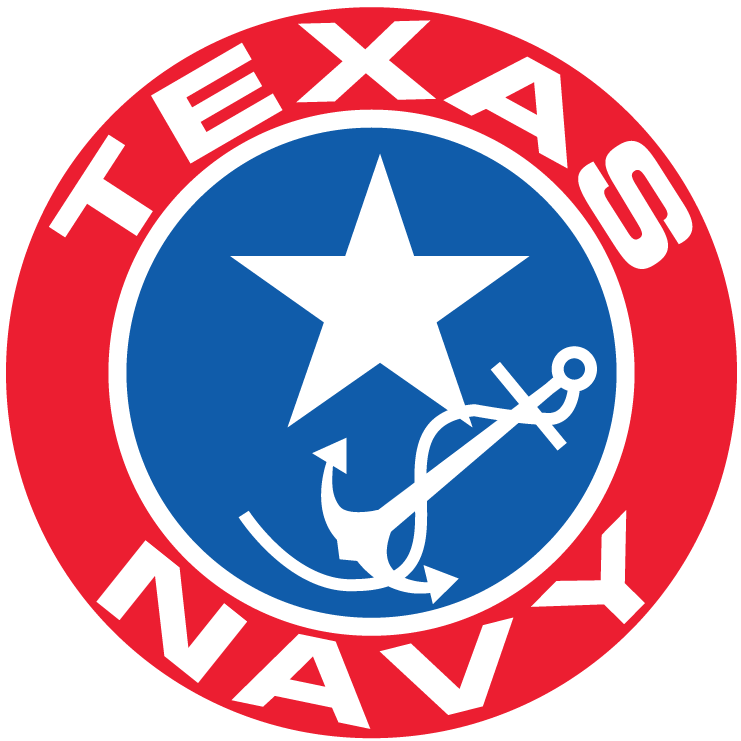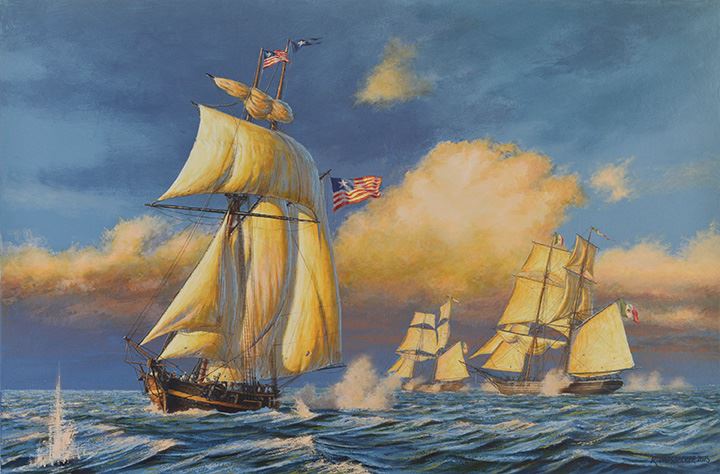 | Texas Navy Association |

"Parting Shot: Invincible in Action off Galveston," by Adm. Peter Rindlisbacher.
FACT SHEET
Search for the Invincible Project
1. What is the Texas Navy Association? The Texas Navy Association (TNA) is a private, 501(c)(3) organization, dedicated to preserving and promoting the historical legacy of the naval forces of the Republic of Texas, 1835-46. The mission of the Texas Navy Association is to preserve and promote an appreciation of the historic character and heroic acts of the Texas Navy; to promote travel by visitors to historical sites and areas in which the Texas Navy operated; to conduct, in the broadest sense, a public relations campaign to create a responsible and accurate image of Texas; and to encourage Texas communities, organizations, and individuals, as well as governmental entities, to participate with actions and money, in pursuit of these objectives. Membership in the Texas Navy Association is open to all persons age 16 and over who have an interest in Texas history and want to help support the goals of the organization.
The Search for the Invincible has been a long-term project of the TNA for many years. Recently the TNA project team brought together information that, we believe, gives us a good new lead on the possible location of Invincible.
2. What was Invincible? Invincible was a two-masted schooner, built at Baltimore in 1835, that was purchased for the fledgling Navy of the new Republic of Texas. Invincible was one of the original four vessels of the “First Texas Navy” (1836-37), during the Texas Revolution. Invincible captured several enemy vessels, including one with provisions that helped feed Sam Houston’s Texian Army in the field before the Battle of San Jacinto. Invincible was wrecked off the eastern end of Galveston Island in August 1837 after a running fight with two larger Mexican warships.
3. How do we know where to look for the remains of the schooner? Several surveys have been done over the years in the search for the remains of Invincible. The current location of interest is near the eastern end of Galveston Island. The location is based on a hydrographic survey done several years after the loss of the schooner. Based on a magnetometer survey done in November 2018 (Phase IA, see below), there are two groupings of targets in the search area that warrant further exploration. One set of targets is large, similar in size to what we would expect of a wrecked vessel, and lies close to the position originally plotted based on historic survey charts.
4. Who owns Invincible and her contents now?
Whether Invincible lies where we currently believe she likely does, or somewhere else in the vicinity, it’s almost certainly under public land, either owned directly by the State of Texas, or a subdivision of local government. Therefore, under the Antiquities Code of Texas (1969) and following legislation, the wreck of Invincible is public property – that is, she belongs to ALL Texans. Any artifacts that may be recovered from Invincible will be conserved, housed, and exhibited under the guidance and regulatory authority of the Texas Historical Commission; all fieldwork will be done under permit from the THC, and final reporting will include recommendations for further approaches.
5. What is a “Phase I” survey? Archaeological fieldwork is often divided into three phases: Phase I is non-invasive testing or recording that does not disturb the site. Examples can include magnetometer testing, ground-penetrating radar, or other techniques. Phase II is testing that may disturb the site in a limited way. This may include coring or limited test excavations done to determine the scope of the site and potentially its value for a full-scale excavation. Phase II projects may include (very) limited collection of artifacts, for the purpose of identifying the type and time period of the site. Phase III is what most people think of when they think of “archaeology”: large-scale excavation of an entire site with the recording, collection, and conservation of all the artifacts found.
The Search for the Invincible Project is currently in the beginning of this process, Phase I.
6. What may we eventually find of Invincible? After she was wrecked in August 1837, Invincible was partly salvaged by the Texians. They recovered some spars and sails and perhaps other things. It is not known with certainty whether they recovered any of her artillery pieces. What was left of Invincible was broken apart in the surf and was not visible above the surface. A few weeks later, racers storm swept through the area, devastating Galveston. It’s very probable that this storm further scattered what was left of the wreck. The remains of the vessel may have been quickly covered over by sand, which would help to preserve them in a low oxygen environment. The site of interest, which was well offshore in 1837, is currently under sand in an area that has been built up over the last 180 years. Any surviving remains of a shipwreck there are likely deeply buried, ten feet or more. Probably little of the vessel’s wooden hull and fittings remain. There may be pieces of the hull still intact, with copper sheathing attached. There would also be some metal fittings left, including (possibly) artillery, anchors and chain, the ship’s galley stove, and a wide range of small items. In addition, there would likely be items of pottery and glass, that were either part of the schooner’s gear or possibly captured prize material that had been stowed in the hold.
7. How is this this Phase I Project being conducted? The first part of the project, Phase IA, was done in November 2018. A well-qualified nautical archaeologist who specializes in remote sensing, conducted a three-day magnetometer survey of a 23-acre plot centered on the coordinates identified by archival chart research. The archaeologist, Robert Gearhart, identified two large groupings of magnetometer readings within the study area that need additional examination. One, in particular, has a large magnetic signature that is broadly consistent with what one would expect a shipwreck to look like, and is close to the location plotted on the historical survey chart. This was Gearhart’s summary description of that larger assembly, “Anomaly 1,” and its possible connection to the second, “Anomaly 2”:
Anomaly 1, in particular, bears a strong resemblance to magnetic anomalies recorded over wood-hulled ships similar in size to Invincible. The anomalous area located a short distance east and southeast of Anomaly 1 may or may not be associated with the larger dipole. . . . If Anomaly 1 proves to be associated with Invincible, the latter area might indicate wreckage scattered down current by storm surge leaving the bay following the passage of Racer’s Hurricane a few weeks after Invincible was lost. Unfortunately, the magnetic sources of anomalies 1 and 2 cannot be identified with certainty based solely on the geophysical evidence. The next logical step in demonstrating whether one or both of these anomalies is associated with a shipwreck, and potentially with Invincible, would be to probe these locations.
Unfortunately the magnetometer survey alone cannot present a clear picture of what objects may be causing the anomalies. Following up on Gearhart’s recommendation, in late December 2018 the Search for the Invincible Committee endorsed his proposal to move forward with another phase of probing Anomalies 1 and 2, under an amendment to the current Phase I Survey permit. This additional probing work is designated Phase IB, while the earlier magnetometer work from November will retroactively be called Phase IA.
Probing (or more formally, hydraulic probing) consists of pushing a pipe, with a flow of running water at the base, through the sand to feel for buried objects. This is a simple-but-labor-intensive process (right) that can located physical objects to a depth of up to 20 feet below the surface. If physical objects are encountered, this will give us a firm depth below the surface, a sense of how continuous or scattered they are, and possibly a general sense of the nature of the material (i.e., wood, stone, or metal).
In addition to the probing, the Texas Navy Association has invited several outside individuals or organizations to apply other remote-sensing technologies to the project, including ground-penetrating radar, electrical resistance tomography, and other techniques. Because none of these are well-established for archaeological projects located in a physical environment like this one, they are considered to be experimental and will be included in an addendum to the project’s current Phase I permit.

With the expansion of Phase I into Phase IA/B, the project has grown significantly in scope, even as it has narrowed (in Phase IB) to a much narrower search area. The costs proposed for the Phase IB are roughly estimated at $13,000 - $15,000, and cover only those associated with the fieldwork itself, highlighted in yellow above. All the other Phase I activities (shaded in green) have already been contracted and funds are in hand for completing that work.
8. What will this Phase IA/B Project produce? The Phase IA/B project will not recover artifacts, and cannot answer definitively whether this site is the wreck of the Texian Navy schooner Invincible. What we hope it will do, and we believe is likely to do, will give us a better picture of whether or not this location is likely a shipwreck, and worth further investigation as the Invincible wreck site. We hope that the probing done in Phase IB will reveal one or more highly localized concentrations of iron or wooden material, that would be consistent with the shipwreck, and would guide us in the development of further surveys, and potential plans for Phase II testing.